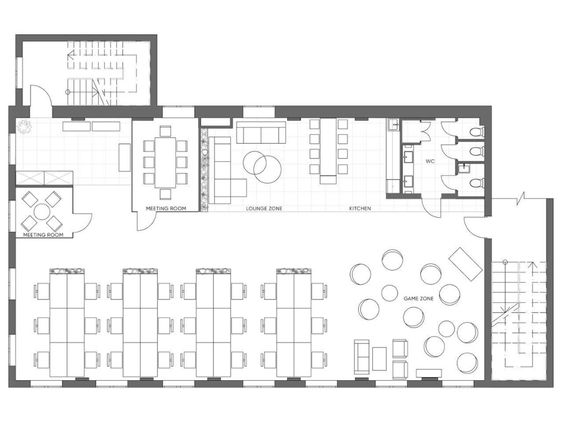
The floor plan of a commercial space is vital for its design and functionality. A well-designed floor plan can enhance space efficiency, traffic flow, accessibility, and overall ambience. This summary will cover creating an ideal commercial floor plan, from assessing your requirements to working with experts. These tips can help you craft a floor plan that caters to the specific needs of your commercial space and ensures a great experience for customers and employees.
Determine Your Needs
The first step in designing the ideal floor plan for your commercial space is determining your needs. Think about how many people are using the space at any given moment, including customers, employees, and guests. Make a basic drawing or layout of the space after measuring its measurements. Make sure to leave enough room for each location while avoiding a cramped or packed layout overall. Take into account any zoning or building code requirements that can have an impact on the space’s architecture or design.
Consider Traffic Flow

Following the determination of your requirements, the next stage is to take the commercial space’s traffic flow into account. To achieve this, it is necessary to comprehend local traffic patterns and maintain a smooth flow of traffic. Determine any potential obstructions to traffic flow, such as congestion or bottlenecks. Identify the main points of entry and departure for the commercial area.
Take into account where windows, doors, and other openings that might impact traffic flow are situated. Make sure that exhibits, equipment, and furniture are not in the way of traffic flow by carefully considering their placement.
Optimize Space Efficiency
The next stage is to maximize space efficiency in the business space after taking traffic flow into account. This includes measuring how much space is being used, selecting furniture, and maximizing storage. Make space allocations based on which functional areas are used the most. To make the best use of the available space, take into account multi-purpose rooms that may be used for many purposes.
Choose transportable or modular furniture that can be quickly adjusted to meet changing requirements. Select shelving, cabinets, or drawers as the best storage options for the objects that require storage. Utilize organized solutions like bins, baskets, or dividers to make the most of your storage space.
Ensure Aesthetics
In addition, aesthetics play an important role in creating the perfect floor plan for your commercial space. This involves designing a visually appealing space that reflects your brand, enhances the customer experience, and creates a positive impression. Choose a design aesthetic that reflects your brand identity and values.
Incorporate brand elements such as colors, logos, and typography into the design. Use lighting, colors, and textures to create a welcoming and inviting atmosphere. Ensure that the space is well-maintained, clean, and organized.
Collaboration with Professionals
Working with experts to design the ideal floor plan for your business space is essential. To make sure that your vision is realized and that the space fulfills your needs and exceeds your expectations, you will need to collaborate with architects, interior designers, and other experts. Create a floor plan that is practical, effective, and visually beautiful in collaboration with the architect.
Make sure the experts are fully aware of your company’s activities and space needs. Make sure the designer fully comprehends your functional needs and specifications. Maintain open lines of communication with all professionals to make sure the project is moving forward and that any concerns are dealt with right away.
Multi-Purpose Spaces
When creating the floor plan for your commercial business whether or not multipurpose rooms or sections are appropriate for your particular commercial enterprise. The layout of a business building It’s important to carefully assess the space you have available and the locations your firm demands. If you own a business that sells various types of fruit and food, are you open to the idea of using one vast space for two assortments of products? When you find ways to eliminate the need for multiple distinct zones, the quantity of wasted floor space in your business building diminishes.
Eliminate Duplicate Spaces
As was previously stated, you must carefully analyze the area you have to work with and the areas you desire. Are all the rooms and spaces you want to include in your floor design truly necessary? If not, consider eliminating spaces that serve the same purpose.
For instance, having separate offices for all the departments is not necessary. Consider moving all the offices together to free up floor space for the customer service centres and product displays.
Consolidate
Consolidate whenever and whenever you can while creating your ideal floor plan for your office building, just as you would eliminate unused areas. Make sure that any areas that require plumbing are close to one another to prevent the requirement for several plumbing cores throughout your structure. If there are multiple plumbing cores, the cost of the building will significantly increase. Your restrooms will be less expensive to install if they are close to any other sites that need plumbing.
Lessen the need for large storage spaces
As a business, you will undoubtedly require storage space, especially in the tangible goods business. However, that does not mean you should overstuff the given area with storage locations. Consider creating a single storage space if you want to combine unnecessary duplicate spaces (there it is again).
This will free up space in your floor plan for other, more crucial, and work-related components. To keep your storage space from getting too cluttered, only place orders when you have limited inventory. Thus, fewer backup products will be required.
Think about how your commercial business operates
When creating a floor plan for a commercial structure, it’s essential to consider the flow of people within the facility. Trace the floor plan to assess how individuals might move around. Too many walls can impede movement, so ensure there are clear pathways. Look for potential vistas and address any gaps in routes between departments.
Also, consider if the departments are adequately sized to accommodate goods and services and whether there’s enough storage space. A well-designed floor plan should promote smooth and efficient movement.
Ensure that customer activities like picking up items, trying them on, and reaching the checkout line are convenient. Once you’re satisfied with the flow, move on to the production and erection phases of construction, turning your ideal floor plan into a reality for your commercial enterprise.
Conclusion
Several crucial phases are involved in designing the ideal floor plan for your commercial location. You may design a floor plan for a commercial facility that is practical, effective, aesthetically beautiful, and conveys your brand identity and values by following these steps.
Level X Construction can assist you if you’re prepared to design the ideal floor plan for your commercial area. Our group of qualified builders has the knowledge and skills to realize your idea from conception to completion.
Make the first move toward designing a commercial space that fits your needs and exceeds your expectations by getting in touch with us right away to arrange a free consultation. Give us a call at 214-799-1565 or visit our website at www.levelxco.com.